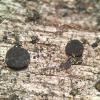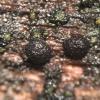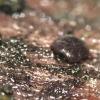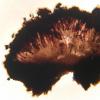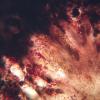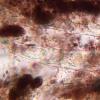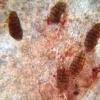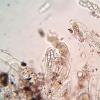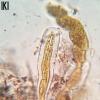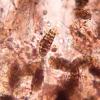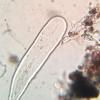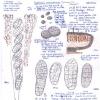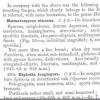
30-12-2025 16:44
Pascal DucosBonjour,Une anamorphe rose stipitée, très nombre

30-12-2025 17:14
 Bernard CLESSE
Bernard CLESSE
Bonjour à toutes et tous,Pourriez-vous aider Albe

29-12-2025 10:15
Hulda Caroline HolteHello, I found and collected this propoloid ascom

30-12-2025 09:04
Hello.A Pyrenomycete sprouting sparsely but very d

29-12-2025 17:44
Isabelle CharissouBonjour,J'aimerais savoir si d'autres personnes au

12-11-2021 00:03
Lepista ZacariasHi everybody,A week ago in my fiels trip I noticed

29-12-2025 17:12
 Bernard CLESSE
Bernard CLESSE
Bonjour à toutes et tous,Pourriez-vous m'aider à
Patellariaceae? Tryblidaria? Murangium?
Ethan Crenson,
28-09-2017 04:26
Asci with 8 spores, bitunicate, about 138-148 x 24-25µm. IKI-
Spores muriform, at first hyaline, finally dark brown, 4-7 septate with longitudinal septa. 25-33 x 10-13µm. It appears that the spores inside the asci are at the larger end of the scale 31-33µm long while the darker spores loose in the centrum are somewhat shorter 23-27µm.
The outer layer appears to be a dark, agglutinated (?) layer appearing red in projected light. It was very difficult to discern any paraphyses or other features.
Because of the resemblance to Patellarioid ascos, I had thought it might be Tryblidaria, but perhaps that's not a very good fit. Can anyone provide me with a shove in the right direction? Thanks!
Hans-Otto Baral,
28-09-2017 07:49

Re : Patellariaceae? Tryblidaria? Murangium?
Hi Ethan
your sample is not in good shape but I think it is a Haematomyxa. I once studied a collection that I identified as Haematomyxa cf. vinosa. It is an American species, originally from New Jersey on Quercus, but I had it on Populus from France (near Montargis, leg. A. Pericouche).
This collection yielded a strong ionomidotic reaction: when adding KOH a deep olive-brown sap extruded and the exudate became blue-green-gray.
Zotto
your sample is not in good shape but I think it is a Haematomyxa. I once studied a collection that I identified as Haematomyxa cf. vinosa. It is an American species, originally from New Jersey on Quercus, but I had it on Populus from France (near Montargis, leg. A. Pericouche).
This collection yielded a strong ionomidotic reaction: when adding KOH a deep olive-brown sap extruded and the exudate became blue-green-gray.
Zotto
Ethan Crenson,
28-09-2017 17:34
Re : Patellariaceae? Tryblidaria? Murangium?
Zotto,
Thank you for your help! I crushed two fruiting bodies and got an immediate olive green reaction when I added KOH. In your notes you mention Tryblidaria/Haematomyxa ? vinosa (in Seaver). I have looked at Seaver's volume on Inoperculates, but I only see "Tryblidium" but no vinosa. Where I can find out more about Haematomyxa?
Regards,
Ethan
Thank you for your help! I crushed two fruiting bodies and got an immediate olive green reaction when I added KOH. In your notes you mention Tryblidaria/Haematomyxa ? vinosa (in Seaver). I have looked at Seaver's volume on Inoperculates, but I only see "Tryblidium" but no vinosa. Where I can find out more about Haematomyxa?
Regards,
Ethan
Ethan Crenson,
28-09-2017 19:04
Re : Patellariaceae? Tryblidaria? Murangium?
Aha! Disregard my comment about Seaver's Inoperculates. I have found "Haematomyxa vinosa" on page 372.
Hans-Otto Baral,
28-09-2017 20:26
Jason Karakehian,
30-09-2017 00:41
Re : Patellariaceae? Tryblidaria? Murangium?
Hi, I was just working on this recently from simillar collections from West Virginia and Kentucky. We thought about Haematomyxa but ultimately came to Tryblidaria fenestrata.
Hans-Otto Baral,
30-09-2017 08:40

Re : Patellariaceae? Tryblidaria? Murangium?
Hi Jason
do your samples show the wine-red-brown pigment (in water) and olive-brown ionomidotic reaction? My studies on T. fenestrata and the close T. azarae show olive-black exudate (in water) that does not change or dissolve in KOH (as in Patellaria) as far as I remember. T. fenestrata seems to differ from T. azarae in hyaline spores with rounded ends vs. yellow-ochre spores (always inside the living asci) with pointed ends.
The colour of the particles among the paraphyses appear to be diagnostic between the two genera: refractive and hyaline in Tryblidaria, red-brown in Haematomyxa. The swollen paraphysis cells with constrictions at the septa might be a further difference between the genera. See my drawings in the Patellaria-Tryblidaria folder:
https://drive.google.com/drive/folders/0B5SeyOEkxxZhejBuVzBCX2tqQTg
Zotto
do your samples show the wine-red-brown pigment (in water) and olive-brown ionomidotic reaction? My studies on T. fenestrata and the close T. azarae show olive-black exudate (in water) that does not change or dissolve in KOH (as in Patellaria) as far as I remember. T. fenestrata seems to differ from T. azarae in hyaline spores with rounded ends vs. yellow-ochre spores (always inside the living asci) with pointed ends.
The colour of the particles among the paraphyses appear to be diagnostic between the two genera: refractive and hyaline in Tryblidaria, red-brown in Haematomyxa. The swollen paraphysis cells with constrictions at the septa might be a further difference between the genera. See my drawings in the Patellaria-Tryblidaria folder:
https://drive.google.com/drive/folders/0B5SeyOEkxxZhejBuVzBCX2tqQTg
Zotto
Jason Karakehian,
30-09-2017 16:09
Re : Patellariaceae? Tryblidaria? Murangium?
Thank you! I will try to get to my notes and specimens, which are not here right now and get back here with some answers! Best - Jason



